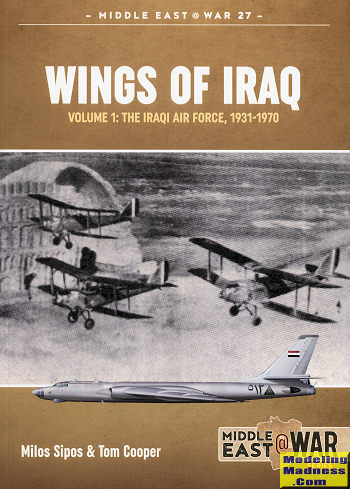 This latest
addition to Helion's Middle East War series concentrates on the Iraqi Air Force
from its formation in 1931 until 1970. Like many of the lands controlled by the
British Empire, Iraq had what was basically a puppet government. The UK acquired
control of Iraq after WWI when a deal was made with France over control of what
had become the Middle East. Much to the dismay of the populace of Iraq, none of
their concerns or desires were taken into consideration when the Ottoman Empire
collapsed as Iraqis had hoped to be self-governing. Such was not the case.
This latest
addition to Helion's Middle East War series concentrates on the Iraqi Air Force
from its formation in 1931 until 1970. Like many of the lands controlled by the
British Empire, Iraq had what was basically a puppet government. The UK acquired
control of Iraq after WWI when a deal was made with France over control of what
had become the Middle East. Much to the dismay of the populace of Iraq, none of
their concerns or desires were taken into consideration when the Ottoman Empire
collapsed as Iraqis had hoped to be self-governing. Such was not the case.
Iraq was not an easy nation to govern. There were
long-standing differences from the various tribes and religious groups that
often boiled over into conflict. This was particularly true when it came to the
Kurds in the north. Much time was spent by the British in 'air policing' Kurdish
controlled territory. It was also not helpful that the Iraqi government, who was
technically in charge, changed as often as one changes one's socks. This became
even more of an issue once the British decided to mostly pull out of the
country.
It was 1931 when the Iraqi Air Force was formed, mostly
using British built aircraft. A build up of the Air Force was possible thanks to
oil which provided weapons funding. Like the British, much of the Air Force was
used internally to try to control insurrections. This use of air power fixed in
the minds of leadership that aircraft was to be used as an extension of the
army. The start of WWII, caused consternation for the British who feared that
the Germans would gain access to Iraqi oil. This concern was shown to be valid
as the then German-sympathetic requested German help in 1941. The British were
quick to respond and the German participation was very short lived.
Post war, the oil kept the funds flowing for new
equipment, still provided by the British. It wasn't until the late 50s that the
use of Soviet equipment became more and more prominent. This equipment was easy
to maintain, inexpensive to purchase, and the Soviets were more than willing to
train pilots and maintenance personnel. It wasn't until the 1967 war with Israel
that Iraqis discovered that the Soviets had terrible air to air missiles after
firing a goodly number against Israeli aircraft with little success. Even after
the 1967 war, Iraq continued to purchase Soviet aircraft and that is where
volume one ends.
Over the last few years, I've grown to really appreciate how well Helion tells
the story of whatever the subject of the book might be. They are well researched
by experienced authors and include a great choice of images. One cannot tell
these stories without weaving in the political story. History is pretty much
about politics and the story of the IAF is no exception. It makes for a superb
look into Middle East politics and why this part of the world is such a hot-bed
of conflict. Highly recommended.
May 2021
Copyright ModelingMadness.com. All rights reserved.
Review book courtesy of
Casemate Publishing, where you can order your copy
at this
link.
If you would like your product reviewed fairly and
fairly quickly, please
contact
the editor or see other details in the
Note to
Contributors.
 This latest
addition to Helion's Middle East War series concentrates on the Iraqi Air Force
from its formation in 1931 until 1970. Like many of the lands controlled by the
British Empire, Iraq had what was basically a puppet government. The UK acquired
control of Iraq after WWI when a deal was made with France over control of what
had become the Middle East. Much to the dismay of the populace of Iraq, none of
their concerns or desires were taken into consideration when the Ottoman Empire
collapsed as Iraqis had hoped to be self-governing. Such was not the case.
This latest
addition to Helion's Middle East War series concentrates on the Iraqi Air Force
from its formation in 1931 until 1970. Like many of the lands controlled by the
British Empire, Iraq had what was basically a puppet government. The UK acquired
control of Iraq after WWI when a deal was made with France over control of what
had become the Middle East. Much to the dismay of the populace of Iraq, none of
their concerns or desires were taken into consideration when the Ottoman Empire
collapsed as Iraqis had hoped to be self-governing. Such was not the case.